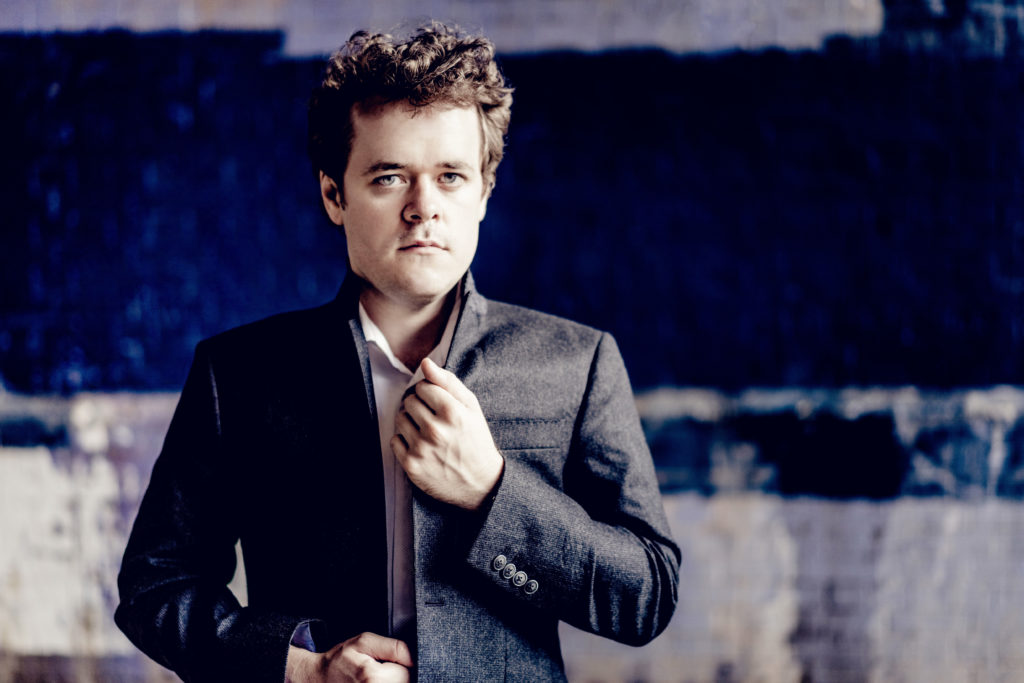The San Diego Symphony’s Bountiful Beethoven at Civic Theatre
The San Diego Symphony’s riveting Beethoven performances Friday at the Civic Theatre owed more than a little to the youthful brio of guest conductor Case Scaglione and solo pianist Benjamin Grosvenor. Choosing less frequently played Beethoven—his Fourth Symphony and the Third Piano Concerto—also contributed to the program’s satisfaction. Of course, without the orchestra’s brilliant ensemble playing and adroit response to Scaglione’s meticulous direction there would be nothing to write home about.
Beethoven wrote his Third Piano Concerto in C Minor as a flashy solo vehicle for himself, which he cannily used to impress Viennese audiences in his early days as a resident that musical capital. Grosvenor, a 30-year -old British musician making his San Diego debut, gave a bold, vivacious account of the concerto’s bravura display, choosing a wide palette of dynamic shadings to underscore the composer’s structural complexity behind the pyrotechnics.Although Beethoven opens the concerto with a profound C-minor gravitas—both in the orchestra’s initial presentation and the soloist’s parallel entry theme— once he has created this somber scene, he jumps to the relative major mode with a cheery, effervescent second theme that dominates the long opening movement. Both Grosvenor and Scaglione handled these contrasts with aplomb, and Scaglione encouraged the orchestra’s dramatic display of the second theme and its development without the slightest sacrifice of its cleanly defined ensemble playing.
In the opening movement cadenza, composed with greater sophistication several years after the concerto’s 1801 premiere, Grosvenor’s technical prowess made the cadenza’s harmonic complexity even more exciting, although he found apt nobility in the middle movement’s ingratiating cantabile theme, suggesting a heartfelt aria from a bel canto opera.
Much has been written about the modest profile of Beethoven’s Fourth Symphony compared to the acclaim and profundity of the Third “Eroica” Symphony and the irreproachable Fifth Symphony. Since the Fourth Symphony is rarely performed, its virtues more easily stand out because audiences are not anticipating every oncoming phrase before it arrives.
Scaglione confidently unleashed the first movement’s ample exuberance that suffused the entire symphony, even the tranquil second movement. Among the orchestra’s laudable solos in the Fourth Symphony, Principal Bassoon Valentin Martchev’s extended athletic contrapuntal forays in the first movement and clarinetist Max Opferkuch’s ardent themes in the Adagio stood out. Opferkuch filled in as Principal Clarinet for this concert, and he filled that position with elan. Scaglione presided over a well-tuned, shapely scherzo, and the orchestra responded with complete assurance to his dangerously bright tempo in the final movement.
Since these two early Beethoven works call for only a fraction of the orchestra’s wind players, it proved a wise choice to open the concert with Igor Stravinsky’s Symphonies of Wind Instruments, a shorter work that uses only winds. The Stravinsky required the orchestra’s full complement of winds, from tuba to piccolo, and it was a pleasure to see them in full force spread across the Civic Theatre stage not seated behind the usual phalanx of strings.
Stravinsky’s work, written as a tribute to Claude Debussy just two years after his death, is neither an Impressionist pastiche nor a clever neoclassical exercise like L’histoire du Soldat from the same period. I hear Symphonies as a solemn, astringent chorale interspersed with slightly florid asides by small clusters of soloists, and under Scaglione’s clear direction, the winds gave an impressive, cohesive account of this rarely heard work.
This concert was presented by the San Diego Symphony at San Diego Civic Theatre on Friday, February 24, 2023, and will be repeated in the same venue on February 25.

Ken Herman, a classically trained pianist and organist, has covered music for the San Diego Union, the Los Angeles Times’ San Diego Edition, and for sandiego.com. He has won numerous awards, including first place for Live Performance and Opera Reviews in the 2017, the 2018, and the 2019 Excellence in Journalism Awards competition held by the San Diego Press Club. A Chicago native, he came to San Diego to pursue a graduate degree and stayed.Read more…


I agree, because it is not heard very often, we don’t have a demented idea of what it SHOULD sound like- and opens us to new possibilities, and nuances. Sounds wonderful, wish I could have been there, especially to see a young talent, well-grounded and technically adroit.